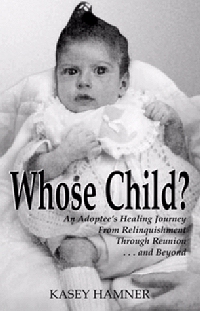
Whose Child?:
An Adoptee’s Healing Journey From Relinquishment Through Reunion ... and Beyond
by Kasey Hamner
Triad Publishing, 2000
Reviewed by Marilyn G. Roy
Curious as to whether Ms. Verrier had written anything else, I looked her up on the Amazon website, and found a second book, Coming Home to Self: The Adopted Child Grows Up, published ten years later. In reading the content description, I noticed striking similarities between the issues discussed in Coming Home and Whose Child?. Ms. Hamner’s comments regarding Verrier’s latest work are included; each highly recommends the other’s work. Verrier states in her review that Whose Child? is “well written and poignant in its honest story....”
I found this book a difficult read. Since I am a birth mother, I questioned whether I was reacting to the author’s ultimate disappointment in the relationship that developed between her and her birth mother. The book was written in 1999, after four years or so in reunion; the author was in her late 20s at the time of their first meeting and her early 30s when Whose Child? was published. Since her birth mother, “Vanessa” (all names were changed for the book), seemed to be doing her best to meet her daughter’s needs throughout this time, I could find no fault with her responses, either to Kasey, or to the situation in which she found herself. An ongoing problem for Kasey is the discovery that both birth parents had told their families that Vanessa’s newborn baby had died in the hospital, thus leaving Vanessa unprepared to cope with a reunion that she thought would never happen. In reality, Kasey was placed in foster care immediately after birth, in October 1967. She was adopted and re-christened by the Hamners in January 1968. We find out as well that, although the birth parents were married at the time of conception and relinquishment, the relationship between them was abusive, enduring for several years after Kasey’s birth—a fact that Vanessa concealed from Kasey until well into the reunion.
Whose Child? is the story of a woman in turmoil, seemingly from the moment of birth until this book was written. The recounting of sexual abuse by an older adoptive brother from the tender age of 4 until she was 16; the near drowning in the family pool, instigated by the same brother, when she was 13; the insensitivity of an adoptive mother whose favoritism toward her sons left Kasey unprotected; and her description of her role in the family as no more than a scullery maid in her adolescence, are heart-wrenching. Her responses: stealing food, binge-eating and anorexia, drug and (mainly) alcohol use, and shoplifting, are undeniable cries for love and attention. A kind, but emotionally distant adoptive father is rarely of help. An excellent student, despite her self-destructive habits, she attributes her survival during those years to her ability to study, eventually allowing her to have a meaningful career as a licensed educational psychologist. As she reunites with relatives from both sides of her birth family, she slowly begins to heal, though the road is sometimes fraught with dead-ends, wrong turns, and many emotional potholes.
My difficulty with the book is not due to the content. Although very painful, her experiences are not unfamiliar, due both to my own personal history, and years of self-help reading. Unfortunately, the poignance of the story is overridden by the immaturity of the writing itself. With the exception of the first 16 pages in the last chapter, titled “Life on Life’s Terms,” the reader might well mistake the author for a young girl, perhaps between 8 and 14 years of age. Not only is every small detail of almost every social interaction described at length, but the desperation for love, and her almost complete self-absorption as she wades through the turmoil, tempted me to put the book down without finishing it several times.
Perhaps some readers will appreciate Kasey Hamner’s style. Perhaps some will find her story brave, a model for healing traumas associated with adoption. I can only suggest that you read it, and judge for yourselves.
Marilyn Roy is a writer and reunited birth mother who lives in Lawrence,
Kansas. She periodically reviews books for this newsletter.
Excerpted from the January 2008 edition of the Operation Identity Newsletter
© 2008 Operation Identity